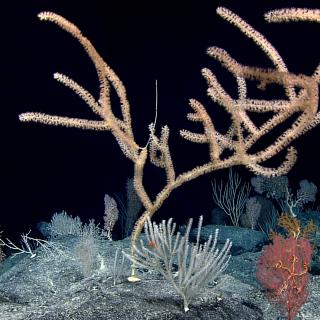Stunning Biodiversity in Palau’s Deep Sea
The first look at the seafloor during the Lebuu’s Voyage expedition wowed witnessing the spectacular biodiversity in the Palau National Marine Sanctuary. Our Corps of Exploration dove ROV Hercules onto an unnamed seamount 45 nautical miles north of Velasco Reef. Hours before E/V Nautilus collected the first ever high-resolution map of this underwater mountain. This compilation video is just a peek into the wonderful world of the deep sea of Palau.
First is a stunning view of a very large Lamprogramus sp cusk eel that measured over 70 cm using our scaling lasers. Further up the slope, the team zoomed in on a “big pink thing,” aka Hemicorallium coral colony, covered with associates like basket stars, squat lobsters, and sea lilies. Deep-sea corals are important ecosystem engineers because they provide shelter habitat and food for dozens of other species in the deep.
Further along the dive, we spotted several deep sea spiders (class Pycnogonida). While they are not true spiders, these predators eat soft-bodied organisms like corals and anemones using their proboscis mouth parts. Look closely to see if you can spot the parasites on its limbs! Continue to be wowed by the diversity of deep-sea critters found in Palau’s waters, including bamboo corals, primnoid corals, snake stars, homolid crabs, snails, and more. The grand finale is a very unique multi-headed Caulophacus sponge!
This expedition to map and explore Palau National Marine Sanctuary, led by Ocean Exploration Trust in partnership with the Palau International Coral Reef Center and NOAA Ocean Exploration, is funded via the Ocean Exploration Cooperative Institute. It was named Lebuu’s Voyage by Palauan stakeholders as part of a strategic effort to advance traditional cultural knowledge and best practices in tandem with scientific understanding.

Lebuu's Voyage I - Palau
Palau National Marine Sanctuary (PNMS) –protection secured by Euotelel a Klingil a Debel Belau– is one of the most ambitious conservation efforts on Earth. Despite being rich in natural and cultural resources, there is very little data available from deep ocean habitats protected within PNMS. Working closely with the Palau International Coral Reef Center (PICRC), NOAA Ocean Exploration, and other Palauan and U.S.





